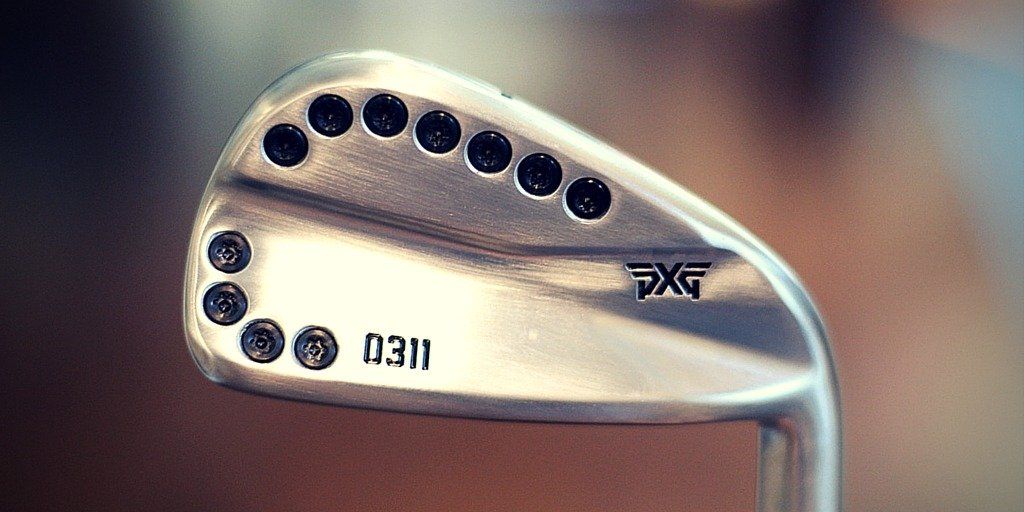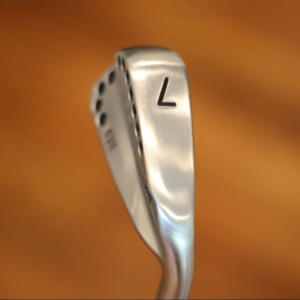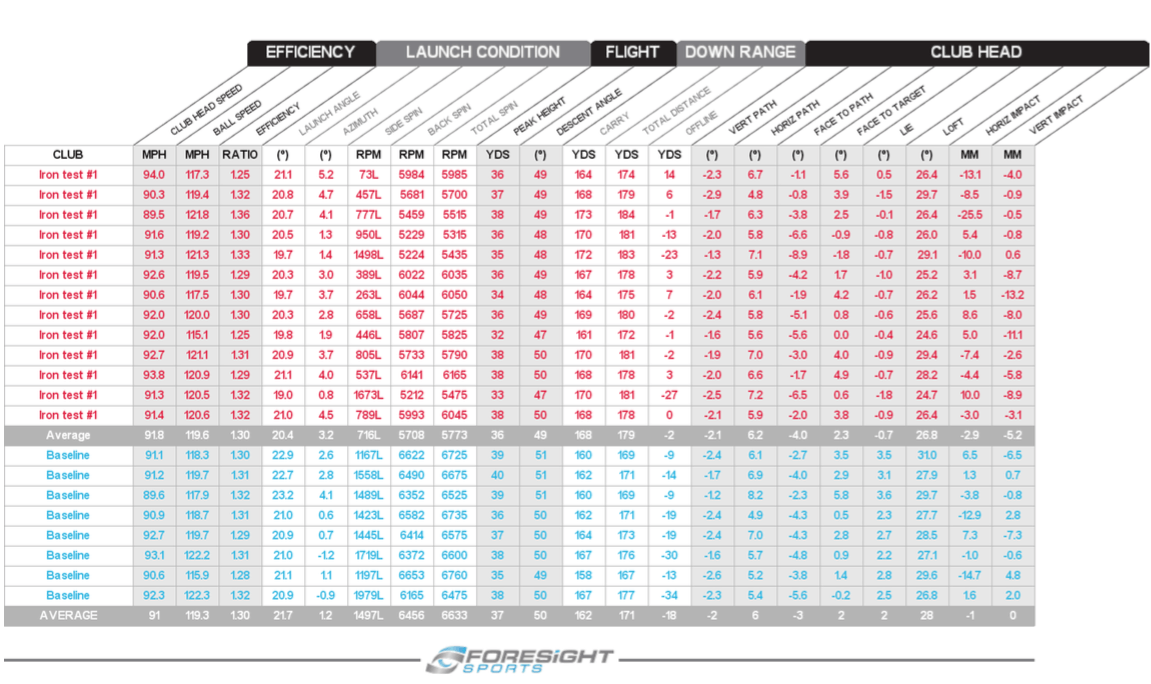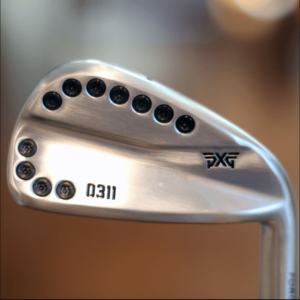
I am not a ‘gear head,’ and do not typically write about golf clubs on this website. I believe down to my core that large jumps in scoring ability come through hard work and changing your approach to the game. Equipment can certainly be a part of that, but ultimately I believe the burden of performance always falls on the golfer’s shoulders.
But that doesn’t mean I am not a lover of golf clubs. I do believe that players can improve their results on the course by seeing an experienced club fitter. Golf is a difficult game, and the last thing you want to do is make it harder for yourself by playing the wrong clubs for your swing. Unfortunately most golfers base their decisions on the marketing claims by various manufacturers.
Recently there has been a story that has caught my eye, and it’s Parsons Xtreme Golf. These are clubs unlike any other I have ever seen, and the company is making some big claims about their performance.
When I heard that Pete’s Golf was going to be carrying the line, I called them up and asked if they were willing to do a test with me. Pete Makowski and Woody Lashen have been helping golfers in the New York Metro area improve their games for over 35 years. These guys are second to none when it comes to experience and knowledge with equipment. It’s the reason why their business has stood the test of time in a very competitive market. So I knew I could get the straight story from them.
After testing the clubs for over an hour in their facility, and then bringing them out on the range, I can say that Parsons is not full of it.
To take a cue from Jason Day’s funny quote from the other week…It’s like a tour-level blade and a game-improvement iron had a baby, and it was the PXG irons.
Update: check out our review of the budget-friendly PXG 0211 clubs
The Story
For those of you who don’t know, Parsons Xtreme was started by billionaire Bob Parsons, who is the founder of GoDaddy. You might remember his Super Bowl commercials with Danica Patrick.
Bob is an obsessive golfer, and apparently is even more obsessed with equipment. Long story short, he gave a blank check to former Ping engineers, and essentially told them to make the best golf clubs ever.
No pressure guys.
Major golf manufacturers are generally restricted by profit requirements when they go to design clubs. They are tasked to make clubs within a certain budget, and that limits engineers on the materials they can use, and how far they can push design concepts.
PXG engineers had no such restrictions.
I won’t go into too much detail in what makes these clubs different from a technical standpoint. It’s a combination of the materials they used, and a unique weighting system that is centered around a colletion of adjustable screws. You can check out their website to learn more.
For the purposes of this article, I am concerned with how they performed.
First Impressions
I did my test with Woody Lashen, who is the co-owner of Pete’s Golf. They are one of the few golf shops in the whole country who carry the PXG line. These are not clubs you are going to be able to purchase off the shelf at your local golf retailer. You have to see an experienced club fitter to make sure they are adjusted for your particular swing.
I have been playing the same Ping i5 irons that Pete's Golf fitted me for over 9 years ago, and I still love them because they provide a ton of forgiveness. At my level (2 handicap right now), I could be playing a tour iron, but I generally stay away from them because I'm more worried about how my clubs will perform when I hit them less than perfectly on the course.
I’ve always felt great golf was about limiting your mistakes (check out my new book to learn how to fix them), and that’s what my Pings help me do.
This is precisely why I wanted to try the Parsons irons. They claim to have the performance and feel of a blade, with the forgiveness of a game-improvement iron. That is an extremely bold claim. But it’s one thing to hear about it, I wanted to see it in person.
Woody had me do a baseline test with my current 7-iron on his Foresight system. Based on my results, he built a PXG 7-iron that he believed would be as close as possible to my current setup so we could see what the difference would be.
The club itself is beautiful. When you address the ball it doesn’t feel like you are necessarily holding a players iron. The face isn't intimidating, and I didn’t feel as though I was going to have to strike the ball on a sweet spot the size of a penny (which is the impression I get with some pro-level irons).

After 10 swings the feedback is immediate. The clubs feel absolutely amazing. I know that I didn’t hit a few perfectly, but the contact still felt very solid. In other words, these clubs feel forgiving.

A Ferrari and SUV at the same time
I asked Woody what he thought of the irons in terms of how they performed, and he gave a great analogy. I thought they were like a Ferrari because they were built to be the best without any regards to cost, and had superior performance.
He said he wouldn’t go that far to call them Ferraris. He suggested that if you had a Ferrari, you wouldn’t want to drive it between New York City and Connecticut. That stretch of I-95 is full of potholes and uneven road where the car would perform terribly. You would actually be better suited to drive an SUV to handle that.
In golfing terms, the blade is the Ferrari, and the SUV is a game-improvement iron. Blades are amazing under perfect conditions meaning when they are struck properly. If you hit some potholes though, and don’t hit them on the sweet spot, they feel terrible and you lose a ton of distance.
Woody felt that the PXG irons were both a Ferrari and SUV wrapped up into one, and that they could handle all of the different shots you’ll hit during a round without sacrificing any performance.
The Data
I’m painting a very pretty picture here, but what's probably most important is what do the numbers say?
If you take a look at the averages from my Foresight summary you can see a few differences from my current irons. I am hitting the PXG irons almost a full club longer. I don’t normally hit 7-irons 179 yards! Also, my spin rate has decreased a bit.

The jump in distance is to be expected because lofts on irons have decreased over the years, and my current irons are over 10 years old at this point. Typically the tradeoff is that you are sacrificing control, but companies have tried to get around that by adjusting the center of gravity on the club, which is exactly what the PXG irons are doing with their unique weighting system.
My biggest takeaway from this session was that I was adding an extra club length of distance without sacrificing any accuracy or drop-off in distance on my mishits. You can see that my worst shots with the PXG irons were still going much further than my current set while remaining on the target line.
That is a huge advantage on the golf course. If I can have an 8-iron in my hands rather than a 7-iron, I will hit more greens on average over time. I still have to make the putts, but there’s no question that increasing greens in regulation percentage will help lower your scores.
On The Range
It’s one thing to evaluate numbers on a computer screen that simulate my ball flight, but I had to see the club perform under real circumstances. So I brought them to my course to experiment in different lies.
I tried to throw every single shot in the book I had. I probably hit over 75 balls. High fades, low draws, big sweeping hooks. There’s no question that I am getting an extra level of maneuverability than my current irons, which is to be expected from a blade.
When I strike the ball perfectly its obvious I am switching into “another gear” of performance. The contact feels amazing, and the ball just takes off. However, that is the case with most pro-level irons. Many players become intoxicated with the feeling, and I think they get tricked into playing clubs that are too much for their ball-striking ability.
What I am more concerned with is what happens when I don’t hit the ball well. I am not a machine, and have plenty of mishits on the golf course. I’ve tried hitting all kinds of tour irons from various manufacturers in the past, and the reason I don’t switch is because of what happens when I don’t strike the ball well. It doesn’t feel very good, and the ball won’t travel nearly as far.
I had quite a few mishits with the Parson Xtreme irons, either on purpose, or just naturally. I would say that the loss of distance and accuracy was comparable to my current set of Pings, which is maybe 5-8 yards at most.
That is where the advantage lies with the Parsons irons. I can get improved distance, feel, and the ability to work the ball without sacrificing that much with my errant swings. If I had made those same swings with a blade I might lose anywhere from 10-20 yards in distance.
There’s just one catch...
These clubs are awesome. I love them, and want to own them. Coming from a guy who constantly engages in debate over club technology, that is saying a lot. Just thinking about returning the 7-iron to Pete's is a sad thought.

There’s just one problem. They are expensive. All of that advanced engineering and high-end materials that Bob Parsons and his team invested in costs a lot of money.
If I want to buy a set of irons from 4-PW it will run me about $2100 to $2300 (not including the cost of the fitting). That’s twice as expensive as any of the other high-end irons out there with the exception of a brand like Miura. If you want a full set of clubs including a driver, fairway wood, hybrids, and wedges it could run you as high as $5000-$6000. That is a shocking amount of money for most people.
I’ve got a two year old son, and a daughter on the way. College isn’t getting any cheaper, so it would be a bit irresponsible to divert funds away from their 529 accounts to benefit my golf game!
Are these clubs twice as good as their competition, which are priced almost at half? No, I would say not. I could play an iron like the RSi 2 from Taylor Made, which is extremely forgiving, but still offers the performance that low-handicap players want.
Am I going to shave serious strokes off my game if I use them? Possibly, but it’s not a guarantee. Maybe I can squeak out a 1/2 - 1 strokes on average if things go really well, which is saying a lot when you are playing close to scratch golf. There is a major psychological advantage when you feel you are playing equipment that is right for your game in addition to any gains in performance on the course. That is why I have always been a proponent of getting fitted for golf clubs.
Parsons is aware that they have an extremely limited market at this price point. My guess is that serious golfers who are obsessive gear heads will be purchasing these. The performance is there, and they are certainly off-the-charts cool. I would say that they could appeal to a player who has a handicap as high as 15 depending on how skilled of a ball striker they are.
Overall, this is a pretty amazing first attempt for Parsons. I love seeing companies who can break the mold with design, and challenge the status quo of any industry.
These clubs are better than anything I have ever hit. I wouldn’t say it’s a gap the size of the Grand Canyon though. Of course this is just one guy's opinion. There are certain players that might not respond well to these clubs.
Are they worth the money though? That’s the million dollar question!
It will be interesting to see how the market responds to Parsons over the next couple of years. I’ll certainly be paying close attention
We care about the protection of your data Read our Privacy Policy